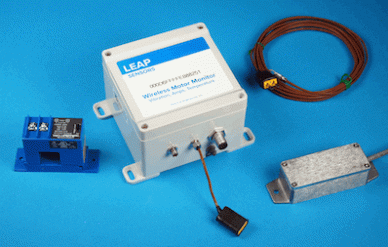
Predictive maintenance is vital to keep equipment running at its peak at all times. In a variety of industries, using wireless sensors for motor condition monitoring helps minimize unplanned shutdowns and reduce the cost of maintenance.
Motors are the workhorses of manufacturing facilities. They are the heart and muscles of conveyors, pumps, blowers, refrigeration systems, compressors, centrifuges, and other hardworking equipment. As such, even one failed motor can lead to huge losses. When a line goes down, workers sit idle and production deadlines go unmet. It also means major expenses, such as when the entire motor has to be replaced rather than one part. In the pharmaceutical industry, for example, a bad motor might lead to losing an expensive batch of drugs.
Motor Condition Monitoring Maximizes Resources
To minimize these costly disruptions, many manufacturers have moved to predictive maintenance, also known as condition-based maintenance. For motors, this process involves tracking key function indicators, such as temperature and vibration, on a regular basis. By using this information to help determine what and when repairs are needed, a manufacturer can replace parts when they are about to reach the end of their service life, thus maximizing the lifespan of the equipment while avoiding unplanned downtime.
How Does Motor Condition Monitoring Work?
A motor doesn’t just operate flawlessly one day and fail the next. In the vast majority of instances, there are indications of potential problems weeks before it breaks down completely. The trick is detecting the warning signs.
There are three main indicators of issues in motors:
- Temperature – an upward trend indicates overheating
- Vibration – caused by misalignment, imbalance, wear and tear, or a loose part
- Electrical current – higher electrical draws indicate an overload
Often, these checks have to be performed manually and with specialized equipment, which means they may occur only quarterly or even twice-yearly. More frequent monitoring can be done, but such inspections still require technicians and downtime. What’s more, some predictive maintenance plans may monitor only one or two indicators. These factors all leave a lot of room for human error and missed signals of possible failure.
Motor Monitoring and Industry 4.0
With the recent development of industrial sensor systems, manufacturers have begun to use sensors for motor condition monitoring. A system of sensors can anticipate impending problems based on the equipment’s actual conditions, and maintenance occurs only when certain operating parameters reach pre-determined values.
Often, however, these systems can be expensive and complicated to install and set up. Comprehensive monitoring would require each motor to have at least three separate types of sensors, and it’s not always easy to find room to retrofit them on existing machinery. Another issue is having the system communicate with a facility’s current software, as well as how to easily analyze and interpret the massive amount of data each sensor transmits. And finally, most of the motor sensors available today are wired, which means extra work, expense, and hassle to get them up and running.
Motor Monitoring Sensors by Phase IV

Wireless sensor for motor monitoring
WIKA has a majority investment in Phase IV Engineering, a leader in motor condition monitoring and IIoT (Industrial Internet of Things) solutions. Their wireless motor sensors, part of the Leap Sensors® system, are the only sensors on the market to combine continuous monitoring of all three of the main indicators of motor health (temperature, vibration, and electrical current draw) on one transceiver node.
Completely wireless, this compact yet powerful system quickly and easily retrofits onto existing equipment: the temperature sensor (thermocouple) and vibration sensor (accelerometer) attach to a motor or gearbox, while the current sensor comes with a split-core amp clamp.
Sensors communicate over-the-air via a gateway and can seamlessly integrate with a facility’s existing software or PLC (programmable logic controller); Phase IV also offers the option of their own cloud-based or locally hosted software. Advanced engineering allows for a strong transmission signal even in industrial environments. If any of the parameters exceed its limits, the system will send a warning by text, phone, and/or email for easy off-site monitoring.
Edge computing (at the sensor level) manages the large amount of data generated by the sensors. By calculating weighted averages to determine if a reading is truly out-of-spec, the Leap Sensor system eliminates false alarms and transmits.
Case Study: How Motor Monitoring Saved the Day…and $100,000
A Fortune 500 logistics company purchased a wireless motor sensor system from Phase IV to install on their conveyor line. Shortly afterward, one of the sensors detected a pattern of rising temperature and vibration, and sent out an alert. Technicians quickly identified the particular motor and discovered the problem: a part of the belt guard had worked itself loose, causing the motor to overheat and shake.
If this motor had failed during a shift, the line would have stopped completely for a complete motor replacement. But because the issue came to light before it turned critical, the company was able to schedule a repair when the line wasn’t running. Due to the time-sensitive nature of their business, unplanned downtimes are not only very expensive, but also impact their customer satisfaction. Thanks to the Leap Sensors, the company estimates that they saved roughly $100,000 in expenses – and preserved their clients’ trust and goodwill.
X-Ray Vision and Crystal Ball in One Device™
Monitoring sensors predict what will happen and allow users to “look” inside a motor. And with the potential of saving companies significant time and hundreds of thousands of dollars per prevented incident, this advance warning system more than pays for itself very quickly. For more information on how to incorporate Leap Sensors into your facility, contact Phase IV.

